
Monstrous Form

A temporary +3/+3 buff for 1 mana. This card reminds us of Power Overwhelming, with its own strengths and weaknesses. Monstrous Form isn’t as strong of a buff, but the minion you buff doesn’t die. As strange as it sounds, the fact the minion doesn’t die can be a drawback sometimes, since Power Overwhelming excelled at popping eggs.
What Monstrous Form can do is push damage and protect a minion for a turn, making it harder for the opponent to kill it through trades or removal, but it doesn’t really help develop the board by itself. If you’ve fallen behind, it can be very weak, as was Power Overwhelming.
There are also no great synergies for Monstrous Form in this set. It’s a card that Imp Warlock could run, but the fact it doesn’t say “Imp” on it could become a problem.
Score: 2
Thornveil Tentacle

This tentacle is a defensive 2-drop. You drop it to the board, randomly hit an enemy minion, and gain back 2 life immediately. If your opponent is forced to trade into it, you can heal for more!
There are obviously some problems here. The damage is random, so there’s no guarantee you’ll land on the correct target, especially later in the game. There’s a big difference between 2 and 3 damage in the early game. Many of the early threats opponents develop cannot be cleanly killed by Tentacle, while they’d be killed by Drain Soul. The other issue is that you might not actually get any healing value that early in the game. Even Drain Soul is rarely played on turn 2, as defensive Warlocks prefer Life Tapping at that stage to dig for more resources, only using removal if the target is particularly dangerous and they could be overrun. The later the game goes, the worse Tentacle gets too.
Tentacle is a decent early game card you can play alongside Drain Soul to boost your survivability, but some Warlock decks could pass on it.
Score: 2
Wing Welding

A lot of players are immediately repulsed by this card since it discards the most expensive card in your hand. After all, this discards our win condition! Why should we play this in a defensive deck that’s trying to survive until it plays that win condition?
Wing Welding is the type of AOE that can be so powerful in its optimal usage, that it might be worth skewing deck building a bit for its potential upside. This card reminds us of Soul Rend, which dealt 4 damage to all minions and was very good despite discarding a lot of cards. It did synergize in Quest Warlock since it pushed the deck into fatigue, but you still didn’t want to discard too aggressively and lose pieces that helped you finish your quest.
Wing Welding could deal much more damage than Soul Rend. Fanottem may not seem like a playable legendary now, but Wing Welding makes it look a lot more viable.
Overall, if we’re playing a Warlock deck that wants to survive at all costs, Wing Welding can be the difference between winning or losing a game. If we find ourselves in a slow matchup, where we are not under pressure, then we don’t play Wing Welding early in the game and avoid discarding our Sargeras. It’s that simple.
Score: 3
Forge of Wills

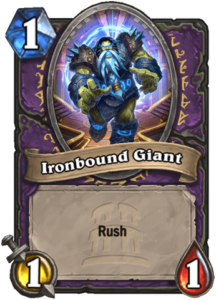
Forge of Wills allows us to select a friendly minion in play and summon a Giant with identical stats, but an added Rush keyword. This begs the question, how many stats can Forge of Wills produce over its two charges?
If the answer is much more than the average 3-drop, then this card is unquestionably nuts and a superb comeback mechanic for the class. One card that’s delicious with it is a neutral 4-drop from this set: Imposing Anubisath. Forge of Wills into Anubisath is a back breaking curve for any opponent.
But a deck like Chad Warlock naturally develops big stuff, so Forge of Wills gives it another way to swing the game and enhance its big turns. Another card to watch out for is Loken, since it also has the potential to produce a lot of stats that can be copied by Forge of Wills. Much like Sinstone Graveyard, this location’s stats per cost ratio is going to be so high that it’s going to warp Warlock deck building. The class is going to prioritize the development of raw stats to swing board states with this card. That’s the definition of a meta defining card.
Score: 4
Mortal Eradication

Mortal Eradication is one charge of Full-Blown Evil that heals for every minion killed by the spell. That makes it infinitely better, as the life gain could be very significant. One of the class’ biggest issues in the current format is its ability to fend off early aggression, as Defile isn’t a reliable answer to moderately sized threats. Two of Warlock’s biggest early game weaknesses are divine shields and buffs. Mortal Eradication lines up much better against those.
This card could be key in allowing Warlock to survive to the mid-game, where it reaches power spikes such as Amorphous Slime. On top of that, Mortal Eradication never really falls off in the late game since you can use it in combination with other removal to get more healing off by “softening up” the board.
We’re not sure Warlock will leverage the card harder with enablers like Enchanter, but what we are sure of is that every single Warlock deck that’s not aggressive in nature, is going to run Mortal Eradication.
Score: 4
Disciple of Sargeras

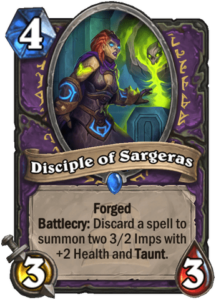
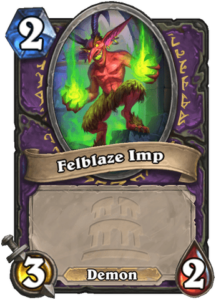
This card is very strange. Disciple is a 4 mana 3/3 that discards a spell (why?) while summoning a couple of 3/2 Imps on the board. At its baseline, it’s not even a particularly good play for the board despite the drawback. Forging this card makes the Imps gain +2 health and taunt. For 6 mana total, we get a couple of 3/4 taunts and a 3/3. That’s okay for the cost but nothing more.
The problem is that this card requires us to forge it to be strong enough, but we’re supposed to be playing Imp Warlock, which doesn’t really like to pass turns in the early game unless it’s placing a Vile Library on turn 2 and going off on turn 3. You could possibly justify Disciple as a setup card akin to Vile Library (pass a turn for greater reward). It might be good enough on the coin (Forge into Coin/Disciple), but what happens if we draw this card at any point later in the game? It becomes exceedingly awkward to leverage and incomparable to the flexible buff from Vile Library that can provide an immediate impact.
On top of that, it has the strangest drawback. If we have Fiendish Circle or Impending Catastrophe in hand, two of the best cards in the deck, then what are we doing here?
Score: 1
Chaotic Consumption
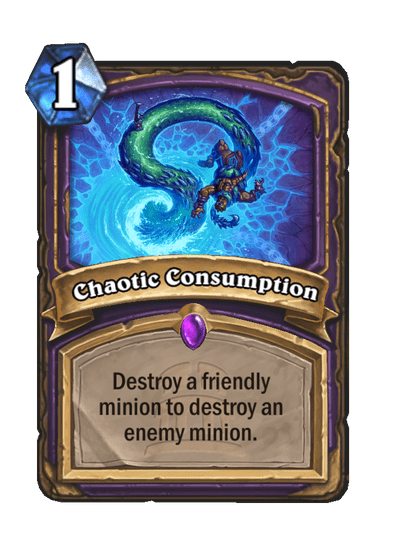
A 1-mana single target removal that requires you to sacrifice a minion in play. This effect has been tried before, but it wasn’t successful because it was too expensive. For 1 mana, we’re starting to talk, though this is still nowhere near as good as Plague of Flames.
The caveat is that we need to sacrifice a minion, which isn’t a big sacrifice in terms of value, but makes it less trivial in practical terms. Warlock either needs to run a package of cheap minions that can consistently enable Consumption, or it runs the card alongside deathrattle minions to turn the drawback into an advantage.
For a deck such as Chad Warlock, you might consider Consumption as an enabler for Amorphous Slime, but it doesn’t really work with other cards and competes with Shallow Grave, which is a very powerful card in the deck.
Other Warlock decks that need defensive tools might be more inclined to run the card, as Warlock’s single target removal isn’t that great. Cheap minions such as Armor Vendor and Tour Guide could act as fodder for the spell. Alternatively, you run a more aggressive deck with deathrattles: Eggs, Kraken and Shallow Grave. The issue with that is a Deathrattle Warlock doesn’t have the finishing potential of an Imp Warlock.
For the mana cost and efficiency, it’s inevitable that Chaotic Consumption sees play. It’s a matter of time.
Score: 3
Imprisoned Horror

Imprisoned Horror does not work like Flesh Giant. It doesn’t get discounted by an instance of self-damage, but it gets discounted by the amount of damage. If you play a Flame Imp, Horror goes down to 6 mana.
Even though this card seems a bit boring, as it’s just a Corridor Creeper without any keywords, it can get discounted incredibly fast. If you’re looking at an Imp Warlock build that runs a few self-damage effects such as Tour Guide, Flame Imp and Spirit Bomb, on top of utilizing the fatigue package (which also provides self-damage), Horror should cost 0-mana by turn 4-5 quite consistently. It’s entirely possible and realistic for Horror to even cost 0 mana on turn 3.
Compare to this Vengeful Walloper and it looks quite strong. Horror may not have rush, but Walloper takes a significantly longer time to discount to 0 mana. That usually doesn’t happen until around turn 6-7.
A 0 mana 5/5 in Imp Warlock? Yeah, we’re playing the hell out of that.
Score: 4
Loken, Jailer of Yogg-Saron


Loken has two different effects that happen in sequence. First, you discover a minion from your deck. Second, Loken summons a Tentacle with the discovered minion’s stats and taunt.
This is baseline 6 mana 3/3. If we’re trying to think of an acceptable stat line for this card to provide a strong enough board presence that doesn’t lead us to fall behind, the taunt needs to be worth about 4 mana. A 4/5 taunt from Loken is just about acceptable. But of course, we can do so much better than that. Loken can be a high value discover card that gets us ahead on board too.
If we’re looking at an archetype such as Chad Warlock, it has a plethora of big minions that become great targets for Loken. Some further tweaks in deck building could help us reduce the low roll possibility. If we can design a list that only has a few weak Loken targets, we can nearly guarantee that this legendary will be a strong play.
But there’s another path, which goes harder on leveraging Loken to be a game winning turn in many matchups. We include three different minions in the deck, one of them being Fanottem and another being Sargeras. This gives Loken the option to tutor our win condition or summon a 15/15 taunt in faster matchups.
So, Loken can either be a tutor that summons a strong body that protects us, or it’s just Barnes. If the Barnes approach is successful, which we think it can be, then this is just a deck warping card of the highest degree.
Score: 4
Sargeras, the Destroyer

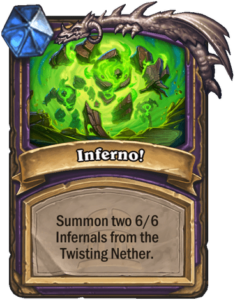
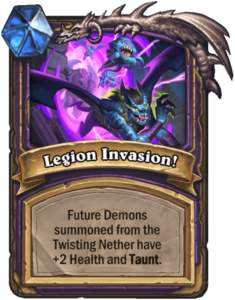
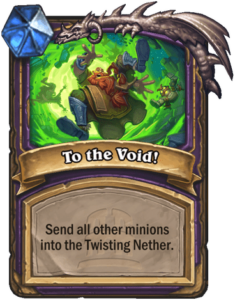
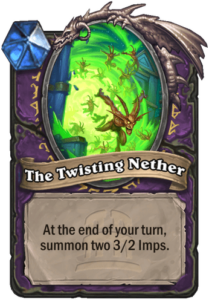

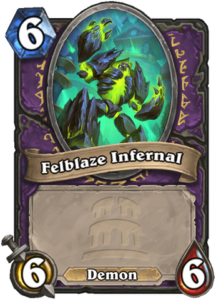
Sargeras is only the second TITAN with a battlecry. He drops a Portal (requires board space) that summons two 3/2 Imps on each of your turns for the rest of the game. The Portal cannot be removed or interacted with, so the Imps provide infinite value. That already makes the card a potential late game powerhouse. This is appropriate since it’s the slowest TITAN to come down to the board at 9 mana and no ability to ramp or cheat it out with Voidcaller (since the Portal is only summoned on a battlecry). His abilities are also related to the Portal.
‘To the Void!’ sends all other minions to the Twisting Nether. This ability is not equivalent to the Twisting Nether spell, as the effect removes these minions from the game in a poof! No deathrattles are triggered and the minions do not get added to the graveyard. They get sucked into the Portal and disappear. This is a powerful reset ability that nullifies all the opponent’s pressure and completely reverses the course of the game. You now have Sargeras on the board as a must-kill target at 12 health and a couple of 3/2 Imps. This ability should win a lot of matchups.
‘Inferno!’ summons two 6/6 Demon Infernals. This might be the best ability to use if you’re not under pressure, but you want to pressure the opponent in one turn. The result is Sargeras, two 3/2 Imps and two 6/6 Infernals, which is a massively threatening board.
‘Legion Invasion!’ makes all summoned demons from the Portal gain +2 health and taunt. That means that your infinite stream of Imps becomes that much stronger and gives Warlock 8 health in taunt every single turn. If you use this ability before using Inferno, then the 6/6 Infernals also gain this buff. This is the strongest long-term ability, one that makes Warlocks extremely difficult to kill without direct damage, since the opponent is constantly roadblocked by taunts that protect the Warlock from minion or attack damage. If you’re not under an overwhelming amount of pressure that merits To the Void, using this ability might be a better choice.
Sargeras is a serious win condition for any late game Warlock strategy. You cannot pass up the opportunity to run a card that provides you with infinite value and protection, especially when it also has one of the best bailout buttons. Mage’s 10-mana hero card, The Amazing Reno, had the same poof effect and it saw play just because it was so powerful. Warlock gets to cast this effect for one less mana and produce a board on the same turn.
Sargeras is a staple that could carry Gul’dan to greatness.
Score: 4
Final Thoughts
TITANS Set Rank: 3rd
Overall Power Ranking: 7th
Our wish list for Warlock before any of its cards were revealed was simple. The class needed more survivability tools so it can bridge into its late game. The class also needed a stronger late game so it can contest the other late game strategies in the format. Our desires may have been met.
Mortal Eradication is a particularly perfect fit for any defensive Warlock deck. Its ability to fend off any early game minions the opponent may have developed while also providing recovery seems powerful. Chaotic Consumption is a single target removal tool that the class may leverage. Wing Welding is a sleeper AOE effect that we think is going to surprise players.
The most notable addition in the survivability department may be Forge of Wills, but it’s a bit unfair to just call it that. This is a massive swing card that can turn a game around and that fits Chad Warlock’s scamming antics particularly well.
When it comes to the late game, it’s hard to argue against Sargeras being the most powerful TITAN in a drawn-out game. Its bailout button is outstanding, while being able to summon an endless stream of Imps with taunt is going to make Warlock so much harder to kill. Though it cannot be effectively cheated out by Voidcaller, there are other ways to cheat it out early. Since Sargeras is an odd-cost card, Thaddius from Amorphous Slime could see the TITAN drop to the board as early as turn 6. Another way to cheat Sargeras with some deck building maneuvers is to draw it off Movement of Pride, which can also lead to a turn 6 Sargeras. A defensive Warlock deck that tops out at Sargeras is certainly possible.
The early game is also getting a boost, with Imprisoned Horror offering Imp Warlock a 0 mana 5/5 that could be quite easy to achieve.
Finally, Loken could be just as influential as Sargeras. At initial glance, he looks quite innocent. It’s an Abyssal Summoner with a discover effect, right? But what happens when we build a Control Warlock deck that can always summon a 15/15 on turn 6 thanks to Fanottem?
ZachO has done this during theorycrafting streams more than once, and it was one of his biggest highlights. At one point, the Warlock’s board consisted of Loken, a 15/15 tentacle with taunt and two 15/15 giants with rush. On turn 6. Is this an Abyssal Summoner, or is it just the reincarnation of Barnes/Y’Shaarj?
Warlock’s set is full of potential. Survivability. Inevitability. Scammability. Festival of Legends ended up being a disappointing time for the class, but perhaps TITANS will finally deliver Gul’dan his destiny.

Just like Starfox says: Thank you zacho! You really make it possible for me to enjoy this game in its full potential!
>If your opponent has a big threat on the board, Golganneth takes care of it.
Not if it has divine shield 🤣
Thx for the good work!
I always enjoy reading your stuff!
Thanks for the review. I appreciate your work. Good luck with the launch!
Of course it’s good with Implock; it’s an IMPrisoned Horror.
I don’t often see many comments on here, so I’ll just say thank you for all of your hard work on this. Not only are you analyzing every card and it’s possibilities, but you’re doing detailed write ups on the potential of each card. Every pre-expansion I look forward to this preview and it never disappoints!
first